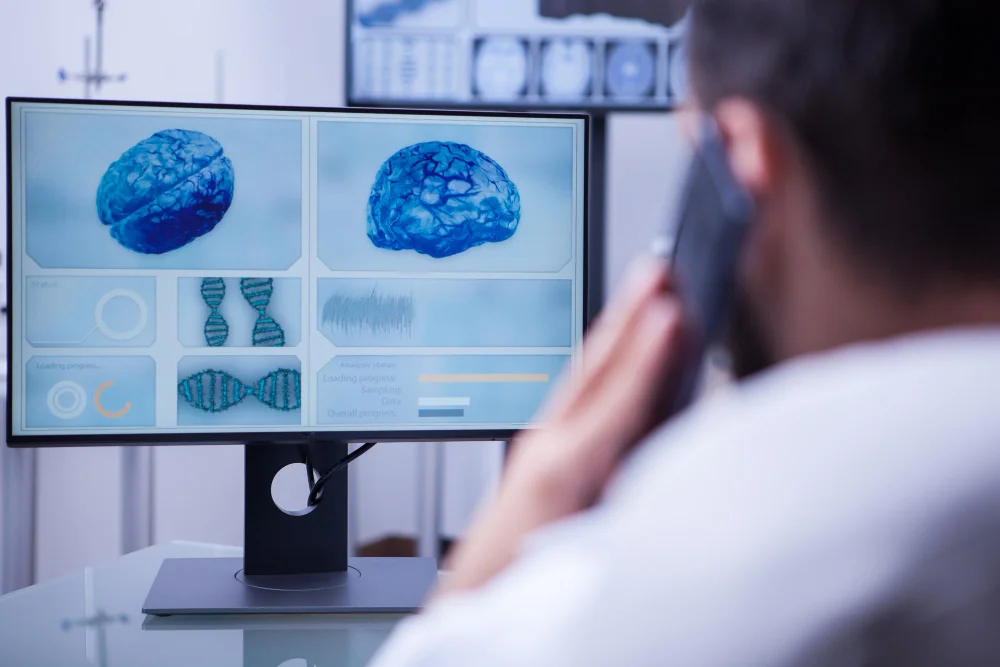Transcranial Magnetic Stimulation (TMS) has gained attention as a treatment for mental health conditions, but many people wonder whether the science backs up the claims. Is TMS effective, or is it just another overhyped therapy?
This article examines TMS effectiveness, exploring the research surrounding its success rate and how it compares to other treatments. Understanding what the data actually shows helps you make informed decisions about whether this treatment might be proper for you.
TMS therapy is increasingly recognized as an effective alternative for treating conditions like depression, anxiety, and PTSD, particularly when traditional treatments haven’t worked. The FDA approved TMS for major depressive disorder in 2008, and since then, its applications have expanded.
How Effective is TMS Therapy?
Understanding TMS Effectiveness
TMS effectiveness varies depending on the condition being treated, the specific protocol used, and individual patient factors. For major depression—the most studied application—research shows that approximately 50-60% of patients experience significant symptom improvement, and 30-40% achieve complete remission.
These numbers represent patients who have already tried and failed to respond to at least one antidepressant medication. For a treatment-resistant population, these success rates are impressive. When you consider that each failed treatment attempt leaves someone more discouraged, a therapy that helps half of these difficult-to-treat patients represents meaningful progress.
Factors Affecting TMS Effectiveness
Several factors influence how effective TMS is for individual patients. Age plays a role, with younger patients generally responding better than older adults. Depression subtype matters too—melancholic depression reacts particularly well to TMS.
The number of previous treatment failures affects outcomes. People who’ve tried 1-2 medications that didn’t work respond better than those who’ve tried 5-10 different treatments. Duration of current depressive episode also matters—people in episodes lasting less than two years tend to respond better.
Treatment parameters significantly impact TMS effectiveness. Higher stimulation frequencies, longer treatment courses, and specific coil placements produce better results.

Research on TMS Effectiveness: What Does the Data Say?
Clinical Studies on TMS for Depression
The landmark study that led to FDA approval enrolled 301 patients with treatment-resistant depression. Results showed that 14% achieved remission after four weeks of TMS, compared to 5% with sham treatment. While 14% might seem low, this represented people who had failed multiple antidepressant trials.
A 2017 meta-analysis published in JAMA Psychiatry examined 81 studies involving over 4,000 patients. The analysis found response rates of 48% and remission rates of 32% for active TMS compared to 24% response and 11% remission for sham treatment.
Real-world TMS effectiveness studies—looking at TMS in everyday clinical practice—often show even better outcomes. A 2019 study of over 7,000 patients receiving TMS in clinical settings found response rates of 58% and remission rates of 37%, suggesting that TMS therapy effectiveness in practice matches or exceeds research trial results.
Studies on TMS for Other Mental Health Disorders
While depression has the most robust research, studies examining TMS effectiveness for other conditions show promise. For anxiety disorders, preliminary research suggests 40-50% of patients experience significant symptom reduction.
PTSD research shows encouraging results, with several studies finding that 30-40% of veterans with treatment-resistant PTSD improved significantly. OCD represents another area where TMS is effective—FDA approval for Deep TMS for OCD came in 2018 based on research showing approximately 38% of patients achieved clinical response.
Success Rates in Real-World Settings
Clinical practice data show that TMS therapy effectiveness in everyday settings matches or exceeds controlled trial results. This is somewhat unusual—most treatments perform better in research settings than in real-world practice.
Insurance data shows that patients receiving TMS have significantly fewer psychiatric hospitalizations and emergency room visits in the year following treatment. This suggests that even when TMS doesn’t achieve complete remission, it often reduces symptom severity enough to prevent crises.
TMS vs Other Mental Health Treatments: A Comparative Look
TMS vs Medication for Depression
Antidepressants help approximately 30-40% of patients with first-line treatment. However, medications cause side effects, including weight gain, sexual dysfunction, nausea, and drowsiness, that lead 30-40% of patients to discontinue treatment.
TMS effectiveness compares favorably to antidepressants for treatment-resistant depression, with response rates of 50-60% in patients who’ve already failed medication trials. TMS produces minimal side effects—mostly mild headache and scalp discomfort that typically resolve after a few sessions.
The main disadvantages of TMS compared to medication are cost and time commitment. Medications cost less and require only minutes per day, while TMS requires daily clinic visits for weeks.
TMS vs Electroconvulsive Therapy (ECT)
ECT remains the most effective treatment for severe depression, with response rates of 70-80%. However, ECT requires general anesthesia, intentionally induces seizures, and commonly causes memory problems.
How effective is TMS compared to ECT? TMS produces lower response rates (50-60% vs 70-80%) but with dramatically fewer risks and side effects. For moderate to severe depression, TMS represents a reasonable middle ground—more effective than trying another medication, but less risky than ECT.
TMS vs Psychotherapy
Cognitive behavioral therapy (CBT) and other evidence-based psychotherapies help 40-50% of people with depression achieve significant improvement. Therapy produces lasting changes in thought patterns and behaviors.
TMS effectiveness doesn’t negate the value of therapy. Research shows that combining TMS with psychotherapy produces better outcomes than either treatment alone. TMS may help people engage more effectively in therapy by reducing symptom severity enough that they can concentrate and participate fully.
Is TMS Effective for Treatment-Resistant Depression?
The Challenge of Treatment-Resistant Depression
Treatment-resistant depression (TRD)—depression that hasn’t responded to at least two medication trials—affects approximately 30-40% of people with significant depression. These individuals face higher risks of suicide, hospitalization, job loss, and relationship problems.
Traditional approaches to TRD involve trying additional medications, combining multiple drugs, or augmenting antidepressants with mood stabilizers or antipsychotics. These strategies help some people but leave many still suffering.
Success Rates for Treatment-Resistant Depression
TMS effectiveness for treatment-resistant depression shows consistent results across multiple studies. Meta-analyses find that approximately 50-60% of TRD patients experience clinically significant symptom reduction, and 30-40% achieve remission.
These outcomes are particularly impressive when you consider that these patients have already failed multiple treatments. Long-term follow-up studies show that many people who respond to TMS maintain benefits for months or years. When symptoms return, repeat courses of TMS often restore improvement.
Addressing Common Concerns About TMS Therapy
Many people worry that TMS is experimental or unproven. The reality is that TMS has FDA approval, decades of research supporting its use, and has been administered to hundreds of thousands of patients worldwide. Insurance companies increasingly cover TMS for treatment-resistant depression.
Some fear TMS will damage their brain or cause memory loss. Research shows no evidence of cognitive impairment from TMS. In fact, studies find that TMS often improves cognitive function as depression lifts.
Cost concerns are valid—TMS typically costs $10,000-15,000 for a full course. However, many insurance plans now cover TMS for qualified patients. When you factor in the costs of ongoing medications, therapy, lost work productivity, and potential hospitalizations, TMS often proves cost-effective over time.

How to Get Started with TMS Therapy
Finding a TMS Provider
Start by asking your psychiatrist or primary care doctor for referrals to TMS centers in your area. You can also search online directories or contact TMS equipment manufacturers for certified providers near you.
Verify that providers are adequately trained and certified. Look for centers affiliated with established medical practices or health systems. Read online reviews and ask about the provider’s experience and success rates.
What to Expect During TMS Treatment
Your first appointment involves an evaluation to confirm you’re a good candidate for TMS. The provider reviews your depression history, previous treatments, current medications, and medical conditions.
Treatment involves sitting in a chair while a technician positions the magnetic coil against your scalp. Each session lasts 20-40 minutes. You’ll hear clicking sounds and feel a tapping sensation, but the procedure isn’t painful.
A standard course involves daily sessions five days per week for 4-6 weeks. Some people notice improvement within 2-3 weeks, while others require the whole course. Your provider will assess your progress regularly and may extend treatment if you’re improving but haven’t reached a complete response.
Hope for Treatment-Resistant Depression
The research clearly demonstrates that TMS effectiveness is real and clinically meaningful. While not everyone responds, approximately half of people with treatment-resistant depression experience significant improvement, outcomes that compare favorably to other treatment options while producing minimal side effects.
TMS has the potential to revolutionize the treatment of treatment-resistant depression and offer hope to individuals who have struggled with mental health challenges for years. As research continues, protocols improve, and more providers gain experience, TMS effectiveness may increase further. For people who’ve tried multiple treatments without success, TMS represents a scientifically validated option worth considering.
